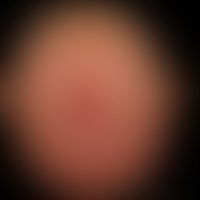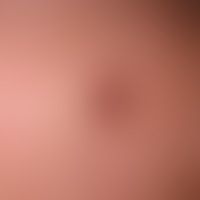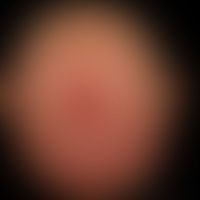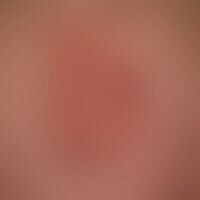Image diagnoses for "Nodule (<1cm)", "Scalp (hairy)"
30 results with 61 images
Results forNodule (<1cm)Scalp (hairy)

Nevus sebaceus Q82.5
Sebaceous nevus: Formation of a pigmented hidradenoma within the clearly defined, hairless sebaceous nevus.

Primary cutaneous cd30 positive large cell t cell lymphoma C86.6

Squamous cell carcinoma of the skin C44.-
Squamous cell carcinoma of the skin: 1.5 cm large, spherical, red node (tumor) with ulcerated surface and hemorrhagic crust on the forehead of a 67-year-old female patient.

Pilomatrixoma D23.L
Pilomatrixoma, reddish-bluish, in a marginal area whitish, 5 mm large tumor on the hairy head.

Cutis verticis gyrata L91.8
Cutis verticis gyrata: cerebriform thickenings, furrows and folds of the capillitium which have existed for years but are increasing; cause unknown; no familial occurrence.

Tinea capitis profunda B35.02
Tinea capitis profunda. Hairless, purulent area, extensive incrustations.

Infant haemangioma (overview) D18.01

Cylindrome D23.4
Cylindrome: firmly elastic, hairless, red knot with a reflecting surface, interspersed with telangiectasia.

Nevus sebaceus Q82.5
sebaceous nevus: Development of different tumor formations in a sebaceous nevus in a 45-year-old patient. In addition to a skin-colored, very rough area with a large basal cell carcinoma, formation of a solid hidradenoma (pigmented tumor on the lower left side). For therapy, the entire hamartoma was excised with a safety margin of 0.5 cm.

Cutis verticis gyrata L91.8
Cutis verticis gyrata: cerebriform (gyriform), symmetrical, asymptomatic folds and furrows of the scalp.

Carcinoma of the skin (overview) C44.L
Carcinoma cutanes:advanced, flat ulcerated exophytic squamous cell carcinoma with massive actinic damage. 82-year-old man with androgenetic alopecia. Pronounced spring carcinoma.

Fibroxanthoma atypical C49; D48.1
Fibroxanthoma atpyisches: rapidly growing, centrally ulcerated, painless lump in a man (>70 years) in actinically severely damaged skin.

Fibroxanthoma atypical C49; D48.1
Fibroxanthoma atpyisches: flat ulcerated lump in a man (84 years), clearly visible in actinically damaged skin.

Squamous cell carcinoma of the skin C44.-
Squamous cell carcinoma in actinically damaged skin: Since more than 1 year, slowly growing, very firm, little pain-sensitive, ulcerated node, which (at the time of examination) was no longer movable on its base. Pronounced field carcinoma .

Blue nevus D22.-

Angiosarcoma of the head and face skin C44.-
Angiosarcoma of the head and facial skin: the 69-year-old patient noticed this rapidly growing and recurrently bleeding 3x5 cm large, little symptomatic node around the capillitium for 6 months. After incomplete preliminary surgery within a few weeks formation of the present recurrent node. The inconspicuous erythema around the node is noticeable. After the micrographically controlled surgery, the tumor was only free of tumor after an approximately 10 x 10 cm large excision.

Blue nevus D22.-
blue nevus. blue-black, coarse, sharply defined, calotte-shaped node with a smooth, like polished, shiny surface. in addition, hairs run through the node. follicle ostia funnel-like indented. especially the detection of hairs in the node area speaks against malignancy (DD: nodular malignant melanoma), because the tumor growth does not infiltrate and destroy the hair follicles.

Blue nevus D22.-

Melanoma amelanotic C43.L
Melanoma malignes, amelanotic: a reddish lump that has existed for years and bled for the first time a few weeks ago, otherwise no other symptoms.

Carcinoma of the skin (overview) C44.L
Carcinoma kutanes:advanced, extensive ulcerated exophytic squamous cell carcinoma with massive actinic damage. 75-year-old man with androgenetic alopecia.




